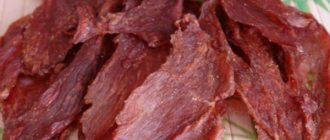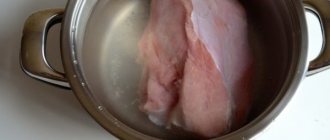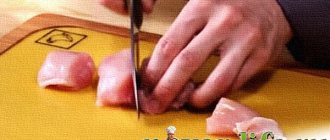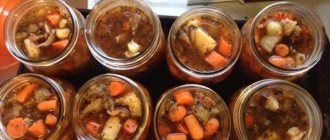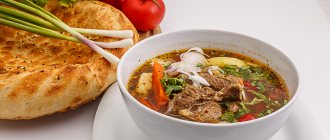Stew at home is prepared from different types of meat - beef, pork, chicken. This dish is extremely popular in Eastern European cuisine due to its versatility. It should be noted that it is very important to follow the cooking technology, especially if you plan to roll up cans of stew. Not all housewives know that insufficient heat treatment of meat increases the risk of botulism, a dangerous disease that often leads to death. But with long-term stewing, the time of which any recipe for preparing canned meat contains, there are no risks.
First of all, you need to choose what kind of meat your stew will be made from. Chicken meat allows you to make a low-fat stew, which is best suited for feeding children. Beef stew has an unusual taste and allows you to make a tasty dish, even if the beef is tough. Canned pork meat is an ideal addition to many dishes.
Stew cooking technology
To make beef stew, it is better to buy beef in large pieces (fillet). Chopped meat - goulash or azu - is also suitable. Although veal is considered a dietary product, it is clearly inferior to beef in terms of protein content and taste. It is highly undesirable to purchase frozen meat. In order for the stew to be stored for as long as possible, it must be filled with fat. Beef itself does not have that much fat, so they use fat of a different origin, for example, pig lard. During cooking, beef meat is reduced by 40%. If you are preparing pork stew, then you can trim off the fat from the purchased meat, and at the end of cooking, simply melt it and pour over the stew. The container needs to be sterile - it must be boiled and dried. If you are going to store it for long-term storage, then glass jars are best. The lids are suitable for both roll-up tin and plastic lids. To prevent the lids from rusting, grease them on top. Store the finished stew in a cool place. If properly prepared, it can be stored for five years.
Advantages of stew
Cooking stew at home has many advantages. The most important thing is that you can always be confident in the quality of the meat used for the dish.
Unfortunately, most manufacturing companies use low-quality meat, which spoils the taste of the stew and makes it fatty. As you know, beef fat is prohibited from being eaten due to its high cholesterol content. This product causes irreparable harm to health. Often in an open can of canned food you will find a lot of liquid instead of meat. Of course, a dish made with your own hands at home will be much tastier, healthier and of higher quality than a purchased semi-finished product.
Situations arise when a large amount of meat appears in the arsenal. For example, you bought a pork carcass for the whole family at a good price. Of course, you won’t be able to eat that amount of meat in one or two times. Freezing it is also not always convenient. At the same time, the product loses many useful properties in the freezer. In this case, preparing the stew and rolling it into jars is perhaps the best option. After this, you can eat a high-quality dish prepared with soul for several months.
Stewed beef, chicken, and pork are canned foods that will help you out in many situations. The advantage is that the meat does not need to be cooked further. It can be added to various dishes - pasta, potatoes, cereals and even soup. You can eat the stew simply with bread and vegetables. Thus, canned food will help out in situations where there is no desire or time to stand at the stove for a long time. Moreover, any lunch or dinner made in just 20 minutes will be complete. Perhaps the most popular dish where such canned food is added is navy pasta. Canned meat and stewed potatoes are harmoniously combined. You can boil the potatoes in pieces, drain the water, add heavy cream and a few spoons of stewed meat and dill - you will get an incredibly tasty lunch.
The dish can be prepared with a variety of spices. It is imperative to add black and allspice, bay leaf, and paprika. For lovers of lean meat, we recommend making chicken stew. In other recipes, lard should be added to the dish, which requires the correct cooking technology.
Fresh lamb, beef or pork stew
Stew can also be made from fresh lamb, beef and pork using the same recipe. It is better to preserve it at home in liter or half-liter glass jars and close with tin lids. Lids and jars are sterilized in boiling water in advance. For warm processing, it is better to use the oven. Cut the meat into large pieces of approximately the same size and add salt to taste. At the bottom of all jars, place one bay leaf, ten peas of bitter black pepper, fill the jar with meat, evenly laying out lean and fatty pieces, and then add fat. Cover the tightly filled jars with lids, place them on a baking sheet previously sprinkled with coarse salt, and put them in the oven preheated to 200°C. After the stew boils, you should keep it in the oven for about two more hours, and only then remove it and roll it up with sterile lids.
Stewed pork in a slow cooker
Honestly, I don’t know how I would manage without this kitchen miracle, but somehow I lived before. Making stew in a slow cooker is faster and almost as convenient as making it in the oven. But, naturally, the portions will be smaller.
We will need three kilos of pork meat and half a kilo of lard or interior fat. If the meat is fatty, then take less lard. The same spices include pepper, salt and bay. In general, there is no need to overuse spices in such preparations, because this is a semi-finished product, you will cook something from it and you need it to be as neutral in taste and smell as possible.
First of all, we cut lard or lard into pieces, put it in a bowl and set the baking mode, melt it and take out the cracklings. We trim the meat and rinse it, dry it and cut it into pieces. We put the pieces into the rendered fat, add all the spices, add salt and set the stewing mode for three hours. We close the lid and go about our business.
In this case, the jars need to be sterilized, we pack the stew, as always, hot and immediately roll it under the lids.
Beef stew recipe 1
Take beef without streaks, sinews or bones, cut into small pieces, put in a pan and fill with water a centimeter above the level of the meat. Then put it all on the fire. As soon as it starts to boil, start skimming off the foam. Then add ten black peppercorns, chopped carrots, parsley, two onions cut in half and cook over low heat. After two hours, add a little salt and remove the onion. After another hour and a half, when the meat is cooked (it’s easy to pierce), add two bay leaves, add salt to taste and boil for about another fifteen minutes, then remove the bay leaf. Without turning off the heat, remove the meat and place it in sterilized liter or half-liter jars and fill to the brim with broth. Then roll up with tin lids, turn over and leave to cool.
Homemade pork stew - general cooking principles
The main advantage of pork for making stew is that this type of meat is quite fatty and therefore does not require the use of additional ingredients in the form of lard, large amounts of fat, and oils.
You can prepare homemade pork stew in jars in the oven, pressure cooker, steamer, multicooker, or autoclave. Regardless of the chosen method, the cooking principle is similar:
• Buy fresh meat for canning: pulp with fat. Frozen meat and bony parts are not suitable for making stew.
• You should not preserve stewed meat in large containers; 0.5-1 liter jars are quite enough.
• The container and lid must be sterile.
• The meat is washed, cut into pieces of the same size, salted, peppered, and mixed. Mix prepared pork, laurel leaves, black peppercorns and other ingredients to taste at the bottom of sterilized jars. Perhaps cook the meat first and then compact it into a container.
• The jars filled with ingredients are covered with lids and sent to prepare. Then they take it out and roll it up.
Beef stew recipe 2
Wash the meat, cut into pieces, sprinkle with salt and leave in a basin for about thirty minutes. Sterilize the jars and lids, put the meat in there, cover with the lids and put them in a cold oven. There is no need to add any liquid, the meat will release the juice itself. Simmer for two and a half to three hours. The meat will shrink during cooking, then pour from one jar into the others. Do everything only with a sterilized spoon. Then remove from the oven and roll up. For a day, put it in something warm, like in a bathhouse.
Beef stew in the oven
Composition (per 3 l):
- beef – 2.5 kg;
- pork fat – 0.75 kg;
- salt – 15 g;
- ground black pepper – 5 g;
- laurel leaves – 6 pcs.
Cooking method:
- After washing and drying the beef, remove films and veins and cut into medium-sized pieces.
- Pass the pork fat through a meat grinder and divide approximately in half.
- Salt and pepper the beef, mix with your hands.
- Place 1-2 bay leaves at the bottom of each clean jar, and spread half the pork fat into the jars.
- Fill the jars with the beef, making sure to pack it down well.
- Place the remaining pork fat on top.
- Cover the necks of the jars with foil. Place the jars on a baking sheet and place in a cold oven.
- Turn on the oven to 180 degrees and wait until the contents of the jars boil.
- Reduce oven temperature to 130-150 degrees.
- After 4 hours, turn off the oven and let it cool.
- Boil the lids that you will use to close the cans of stew for 10 minutes.
- Remove the jars from the oven and roll up.
Stew prepared according to this recipe is good even at room temperature, but to be safe, it is still better to keep it in a cool place.
Stewed chicken
For stewing, chicken meat can be used along with bones. Wash the singed and gutted chicken and remove the entire skin. Then cut into large pieces, add salt and place in glass jars. Add chicken fat (if available), ten peas of hot black pepper, one-fourth teaspoon of turmeric, spicy dry herbs of savory or marjoram. Place the jars on a baking sheet, sprinkle with coarse salt, and cover with lids (they are only needed for stewing). Put it all in the oven, preheated to 200°C, and keep it after boiling for at least two more hours. After this, remove and immediately roll up with sterile lids. Stewed duck, turkey and goose are also prepared.
Stewed rabbit meat
Prepare a 25-liter enamel tank, seven liter jars and seven metal lids. Place a wooden circle at the bottom. The lids and jars must be sterilized over a boiling kettle for about ten minutes. Using a sharp knife, remove the meat from four to five rabbit carcasses. This is enough to fill the jars. Separate the rabbit fat and place it separately. If they are not fatty, then you should make a little fatty pork meat (fat), cutting it into pieces the size of a walnut. At the bottom of all jars, place one or two scalded and well-washed bay leaves and lard or rabbit fat in a two-centimeter layer. After this, pack the rabbit meat tightly into the jars. In all jars, put two or three cloves, five to six black peppercorns, three or four allspice peas. And also add a teaspoon of salt. Pour two to three centimeters of lard or rabbit fat on top. Once the jars are filled to the brim, cover with lids and place in the tank so that they do not touch each other or the walls of the tank. Fill it up to the hangers of the jars with warm water and place on low heat.
As the meat, water in the tank and jars heat up, increase the flame, and when the water boils, turn down the heat so that the water does not boil too much and does not splash the jars. To ensure that the lids lie tightly on the jars and do not lift, place a wooden circle on top of them so that it covers all the jars. Close the tank tightly with the lid. Occasionally adjust the boiling point of the water, and adjust the jars with the blade of a knife so that they do not touch the tank. Five hours after the start of boiling, remove the jars and roll up without lifting the lid. Shake the rolled jar a little to mix the contents. Do this not very sharply and carefully so that the lid does not fly off. Then turn it upside down and listen for any hissing. If there is, then such a jar needs to be rolled with a machine again and marked. It’s better not to store it for a long time and open it first.
Homemade pork stew recipe
For preparation we will use the following ingredients:
- Five kilos of pork
- Eight hundred grams of lard
- A teaspoon of table salt for every kilogram of meat
- Bay leaves, black peppercorns and allspice to your taste
How we will cook:
We consider five kilos of meat already clean, processed, that is, you need to cut off all the films and veins, then the stew will be soft and tender. I always use young pork, up to 60 kg, the meat is much softer and not so fatty. The cut pieces should be rinsed with cold water and blotted with a paper towel.
To prepare stew, you need to choose the right utensils. It could be a pressure cooker, as they used to do from aluminum casting, or it could be a cauldron, I use real cast iron, my grandmother’s inheritance, everything tastes better in it.
We cut the lard into not too small pieces and place it on the bottom, set the minimum temperature and begin to slowly melt. If you are going to store the stew for a very long time, you can add up to a kilogram of lard.
Before adding meat, you need to coat the walls of the dish with a melted piece of lard. We cut the meat into pieces, only larger than for roast. We put it in a cauldron and continue to simmer over the lowest heat, sometimes don’t forget to stir. Cook for 4-5 hours, it all depends on the quality of the meat. At the end, add all the spices.
I would like to give one piece of advice to those who are making pork stew for the first time: roll it in small jars, half-liter or seven hundred. It’s more convenient, it’s immediately opened and used, it doesn’t sit for long and doesn’t spoil in the refrigerator. The jars, of course, need to be sterilized and dried. I always sterilize in the microwave, they come out immediately dry. I put the metal lids in a saucepan and boil for five minutes.
You need to lay out the workpiece hot, it is better to do this with a wooden spoon, as well as stirring. Roll up immediately and leave to cool. We store jars in the cellar or refrigerator.
